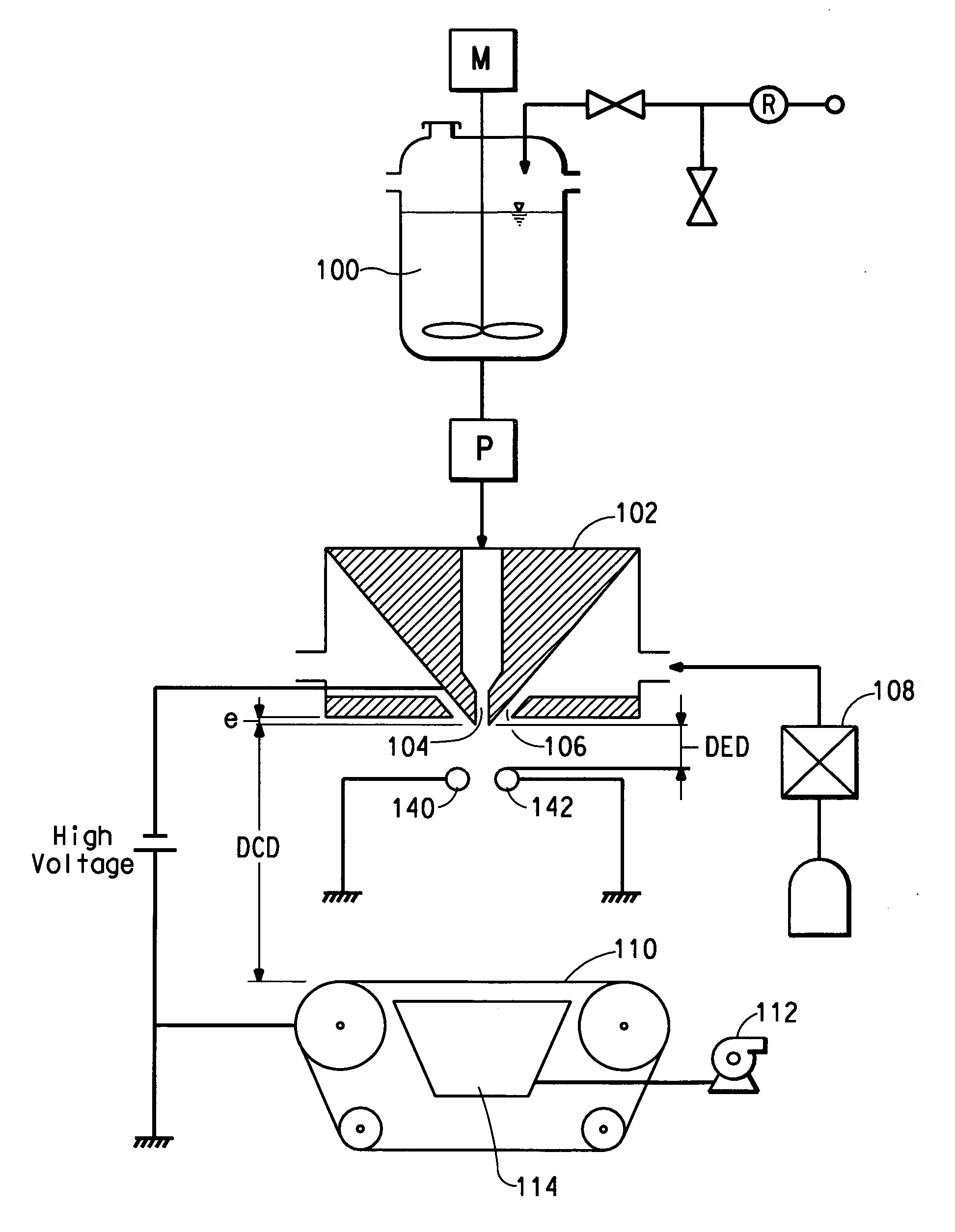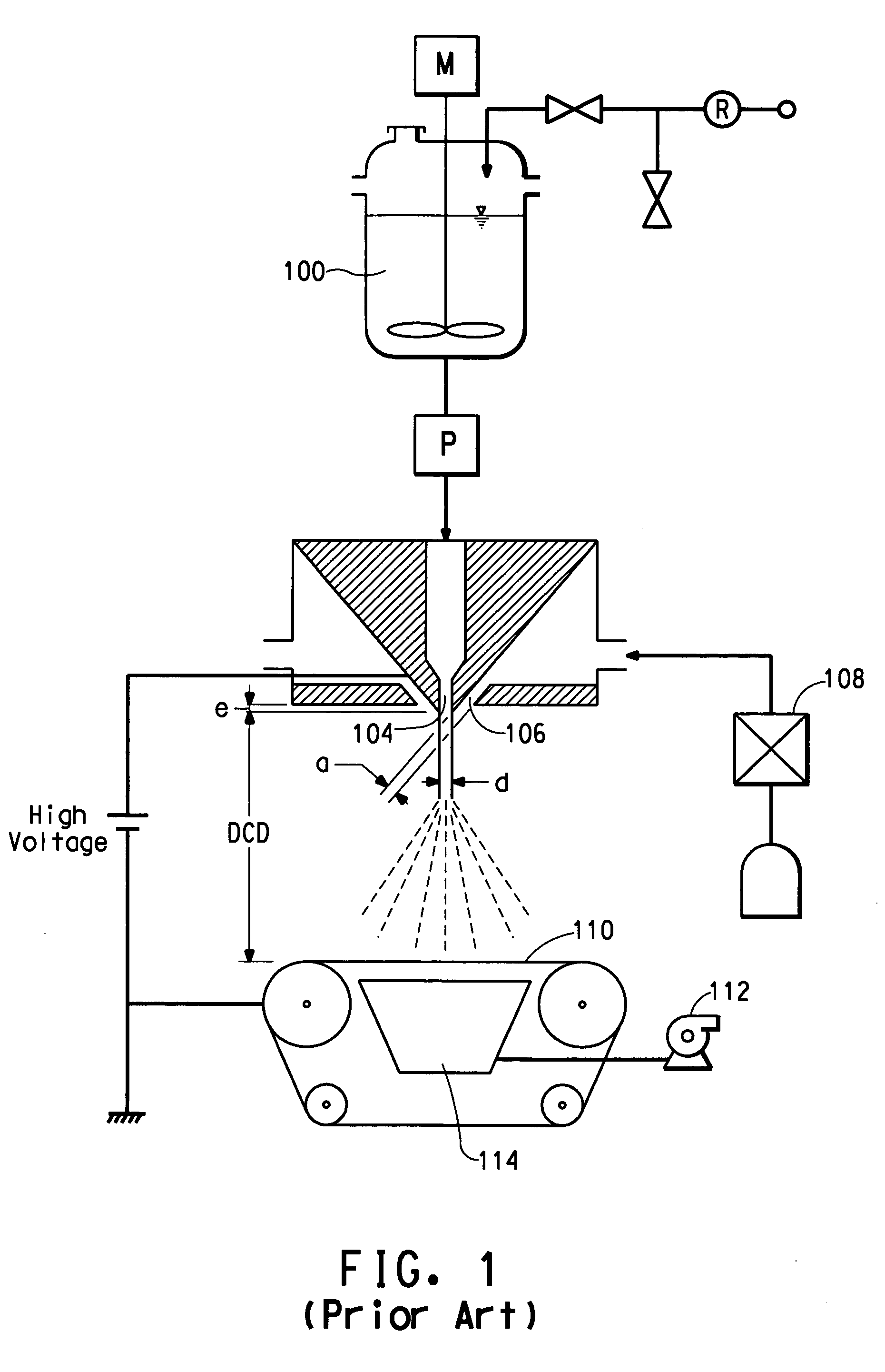Electroblowing web formation process
a technology of fiber web and electroblowing, which is applied in the direction of filament/thread forming, monocomponent polyether artificial filament, fibre treatment, etc., can solve the problems of the coupling distance of the spinning nozzle to the voltage used, and the need for quite high voltage use, etc., to achieve the effect of sufficient strength
- Summary
- Abstract
- Description
- Claims
- Application Information
AI Technical Summary
Benefits of technology
Problems solved by technology
Method used
Image
Examples
example 1
[0026] Poly(ethylene oxide) (PEO), viscosity average molecular weight (Mv) ˜300,000, available from Sigma-Aldrich, St Louis, Mo. is dissolved in deionized water to make a 10% by weight PEO solution. The solution electrical conductivity is measured to be 47 Micro-Siemens / cm using a VWR digital conductivity meter available from VWR Scientific Products (VWR International, Inc., West Chester, Pa.). The solution is spun in a single orifice electroblowing apparatus comprising a 26 gauge blunt syringe needle, in a concentric forwarding air jet. The needle tip protrudes 2.5 mm below the conductive face of the spin pack body. A high voltage is applied to the spin pack body and the spin orifice. The PEO solution is directed through a ring-shaped electrode, which is electrically grounded through an ammeter. Suitable process conditions are in the Table, below.
[0027] PEO fibers are formed via this process and are collected on a conductive surface and examined under a scanning electron microscop...
example 2
[0028] The procedure of Example 1 is followed except with a smaller inside diameter electrode, with the electrode located closer to the die tip and with a lower voltage applied to the spinneret. Suitable process conditions are listed in the Table, below. Nanofibers are collected having fiber diameters ranging from about 100 to about 700 nanometers.
[0029] The procedure of Example 2 shows that by decreasing the electrode inside diameter and decreasing the DED, the applied voltage to the spinneret can be reduced and still generate similar sized fibers as Example 1.
example 3
[0030] The procedure of Example 2 is repeated except with a slightly higher voltage on the spinneret. Suitable process conditions are listed in the Table, below. Nanofibers are collected having fiber diameters ranging from about 100 to about 700 nanometers.
TABLESpinning ConditionsEx. 1Ex. 2Ex. 3Throughput (mL / min)0.50.50.5Volumetric Airflow (L / min)24.524.524.5Air Flow Velocity (m / s)121212Electrode Inside Diameter (mm)28.222.922.9Die to Electrode Distance (mm)25.412.712.7PolaritynegativenegativenegativeVoltage (kV)301416Die to Collector Distance (cm)303030
PUM
| Property | Measurement | Unit |
|---|---|---|
| voltage | aaaaa | aaaaa |
| voltage | aaaaa | aaaaa |
| distance | aaaaa | aaaaa |
Abstract
Description
Claims
Application Information
 Login to View More
Login to View More - R&D
- Intellectual Property
- Life Sciences
- Materials
- Tech Scout
- Unparalleled Data Quality
- Higher Quality Content
- 60% Fewer Hallucinations
Browse by: Latest US Patents, China's latest patents, Technical Efficacy Thesaurus, Application Domain, Technology Topic, Popular Technical Reports.
© 2025 PatSnap. All rights reserved.Legal|Privacy policy|Modern Slavery Act Transparency Statement|Sitemap|About US| Contact US: help@patsnap.com



